|
TennisOne Lessons Backswing Basics Doug King In my previous article I discussed the role of the follow-through in the stroke. In it I stated that the follow-through is often given too much weight in it’s overall impact on the result of the stroke. Although it has significant contributions in terms of controlling stroke tempo and proper acceleration, it can sometimes be a source of distraction for players who focus on the follow-through more than the actual contact of the ball. In this article I will discuss how our perception of the backswing has evolved and how, in my opinion, it needs to continue to change. In the past the most attention the backswing was granted was to simply to get it over with as quickly as possible. Although we still will hear the throwback comments of “get your racquet back quickly,” today we are instead persuaded on the merits of the “Unit Turn” or even the “delayed backswing.” Clearly we are gaining an understanding that the backswing is more than just something that needs to happen fast. It requires rhythm and precision and it’s relevance to the success of the contact cannot be undervalued. Upon close examination we will see that the backswing is actually very complex and multi-faceted. But before we get there we will start with an overall understanding of the role of the backswing.
The role of the backswing is two fold; one is to orient the body and the swing path to the ball and target, and two is to develop force for the powering of the ball. The first part of the backswing, orientation, involves a quick sideways adjustment of the body to one side or the other and the proper grip change. In a game like baseball or golf you have an orientation to the plate or to the ball but you would not refer to that as “backswing.” When a golfer steps up to a ball and adjusts his feet and his grip we do not call that “backswing.” The backswing does not start until the club is actually drawn back on its backwards path. In tennis, however, we tend to blend these two motions together. “Turn and racquet back” are often done in one simultaneous motion - both lumped into the term “backswing.” For clarity it is better to break these actions down into separate moves. The initial orientation of the body and the grip out of the Ready Position should be done quickly but that move should have a separate identity from the “racquet back” stage of the backswing. This initial orientation is commonly called the Unit Turn. The second role of the backswing is to create power to drive the ball. When we begin to talk about powering the ball it is important to understand that there are all types of ways to generate power that will move the ball and each sport has its unique powering system. These different powering systems produce different kinds of swings and different characteristics of contact. Baseball, golf, hockey, racquetball, all have unique contacts that can vary from slaps, whips, hits, rolls, and so forth. Although all of the sports have similarities to the swings, each type of contact has a slightly different power system. This is critical to appreciate since the way you prepare the racquet will determine what kind of powering system you will use. The Body Load
The loading process is done primarily in the body. In a general sense the main spring that we are loading up is the spine of the body. When we load or windup for our stroke we are building tension into the body by coiling and bending. We coil around the vertical axis of the body and we compress by bending at the ankles, knees, and waist. The body should be bent but never to the point of losing balance. Increased leg and core strength will allow the body to coil and bend more and thus generate more stored energy without losing balance. We store this energy until we are ready to release it at the right moment to meet the oncoming ball. Instead the arm should be kept passive and should not start it’s windup until after the body has already progressed with a proper loading action. The racquet should always move in a smooth, controlled action through the backswing. Our well intentioned encouragement to get the racquet back quickly will often prevent proper loading of the body and lead to a faulty arm swing. The arm is actually pulled into the ball by the force of the body being rotated and straightened. The arm is not actually swung out at the ball but rather it is sucked into the “slot” (the and then driven against the ball as part of the body. The arm should always act passively to the body in the backswing or loading phase of the stroke. It should be kept relaxed and should never initiate movement but should always lag behind the movement of the body. As the arm is drawn into the slot it will build up tension through flex and coil. As the arm drops and is drawn forward there is still loading going on so in this respect the “backswing” is still going on since loading is still occurring.
The Arm Load The secondary spring that is loaded is the arm itself. Not only does the body coil and bend but so does the arm. The winding of the body will create an initial take-back of the racquet but there is a secondary take-back that is performed in the arm itself. This for many is the most pronounced feel of taking the racquet back as the racquet is actually “felt” in the hand so at that time when you feel the wrist flex back is the time when you actually feel the racquet go back the most. This is done in coordination with but not at exactly the same time as the loading of the body. The arm goes much faster than the body so to properly time the release of energy so that the arm and the body are together at contact, the arm loading must be delayed behind the loading of the body. If timed properly, the loading of the arm is actually completed during the initial releasing phase the body. This produces increased acceleration in the arm through contact. The Continuous Fluid Backswing It is nearly impossible to clearly separate the strokes into stages of backswing, forward swing, and follow-through. Is the racquet “back” at the highest point of the backswing, or the lowest, or when the wrist is most flexed back, or when the body finishes the turn? There is no exact position that marks when the racquet is back. Because of the dynamic nature of the stroke, it almost defies this kind of analysis. In fact to think of the stroke as a back and forth action is, in my opinion, not very helpful at all. It is better to think of the stroke as a rotation back and under and then a releasing action.
Imagine a starting point for the stroke just slightly behind the contact point of the ball and then a windup phase that eventually brings the racquet back very close to the same point but now cocked back and down and loaded up with stored energy that is then released into the ball. This release is more of a thrusting lift of the ball rather than a forward swing and hit of the ball. In this respect I would define the end of the “backswing” or the loading, as the point where the racquet is the most cocked back and down in the hand. In a typical low-to-high topspin drive this usually occurs very close to the contact of the ball. Notice how the racquet is positioned in front and above his hand as he makes the initial “spot” of the contact. Then he makes a fluid rotation until the racquet is behind and below his hand just before contact. You can see that the racquet is actually rotating around the arm as though the arm is a “stem” protruding at the side of the body. Sometimes this “stem”, or imaginary horizontal axis which the racquet rotates around, is delineated by the extension of the non-hitting arm just after it leaves the racquet, as demonstrated by Agassi in the video. This stem shifts from the side to the front as it is repositioned by the rotation of the body. This body rotation repositions the palm of the hand from where it faces the side fence just prior to contact to facing the target right at the moment of contact.
In watching the Agassi stroke try to visualize the end of the backswing not at the point where the racquet starts to come forward but instead at the point where the racquet starts to lift up into contact. Notice that even though the arm starts moving forward there is still folding back occurring in the wrist and coiling back in the forearm. This backward loading in the forearm does not stop until the racquet hits the bottom of the swing path. You will see that this point is very close to contact and from that point he makes a powerful and controlled “thrusting lift” on the ball which is his acceleration or “trigger point.” The result is a fluid, dynamic stroke that has power and flexibility and is not hampered by stops and starts, extended and stiff positions and back and forth swinging. It is very compact to the body which makes the entire stroke more balanced, quicker, and more stable. This stroke motion should not be characterized as a “back and forth” action as much as a “rotation into the ball” - a rotation of both the body and the arm. The body rotates on the vertical axis of the spine while the racquet rotates around the horizontal axis of the arm (the two springs), thus creating torque. Hence “windup” is a better description of the motion than “backswing.” The result of this kind of motion is that power is loaded and released in an acceleration that is directed to a more precise point in space and time rather than released in a steady stream and longer path of a back and forth swinging action. This produces more consistency of timing and control of the contact of the ball. Backswing Variations: Full Loads and Semi Loads In many cases we do not have time, the occasion, nor the reason for a fully loaded backswing. This is especially true at the net on volleys or on the return of powerful first serves, for a drop shot, and other underspin shots. In these instances we use an abbreviated backswing. This abbreviated backswing may start exactly like the normal backswing but it is halted midway through the loading phase. The racquet is then brought into contact from a different position and with less stored energy to release on the contact. Instead of the forearm being fully flexed and rotated resulting in a racquet head position below the hand, the racquet head approaches contact from a position that is less flexed back and above the hand. This will impart underspin on the ball and will lessen the amount of power released through contact.
Summation
The backswing is the most designed and controlled part of your swing. It sets into motion the subsequent phases of contact and follow-through that should flow naturally out of a proper windup. Try to develop a sense of rhythm and body and racquet awareness in your backswing rather than simply trying to get it over with quickly. Like with many things faster isn’t necessarily better. Learn to coordinate your backswing and you will slow down the game and move your play forward. Your comments are welcome. Let us know what you think about Doug King's article by emailing us here at TennisOne.
Doug is one of the country's foremost tennis teaching innovators. Founder of Acceleration Tennis, a revolutionary teaching system, King is leading the way in reinterpreting the traditional tennis model. Doug King is currently Director of Tennis at Meadowood Napa Valley ( www.meadowood.com ), a Relaix Chateau Resort in St. Helena , CA . For more information on Acceleration Tennis please email Doug King at dking@meadowood.com. |

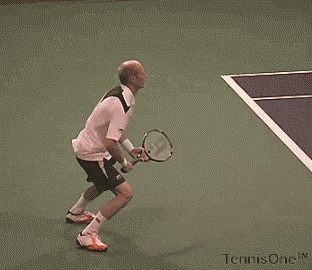
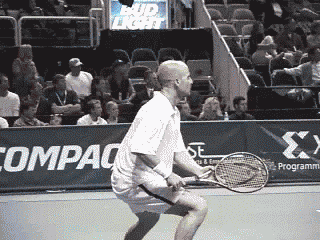
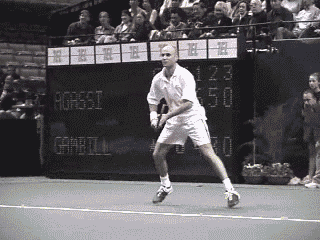
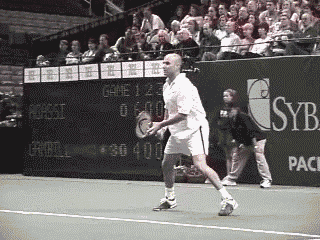
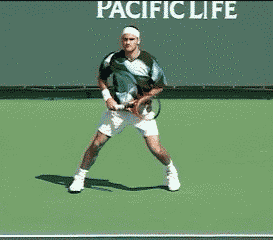
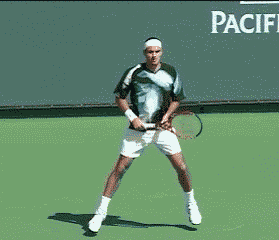
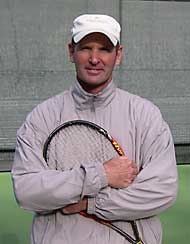
 Doug King studied with legendary tennis coach Tom Stow and was a
former California State Men's Singles Champion
and the former number one men's player of Northern California.
Doug King studied with legendary tennis coach Tom Stow and was a
former California State Men's Singles Champion
and the former number one men's player of Northern California.